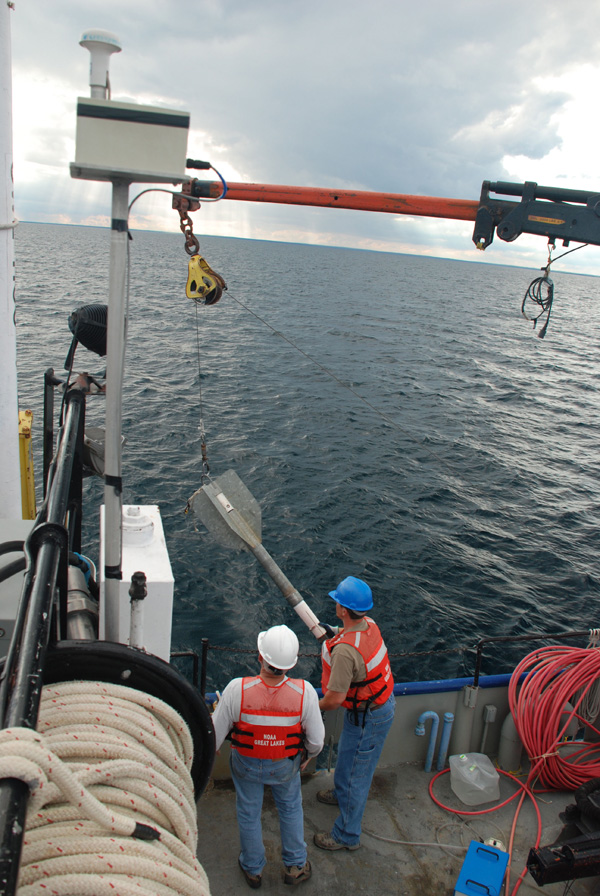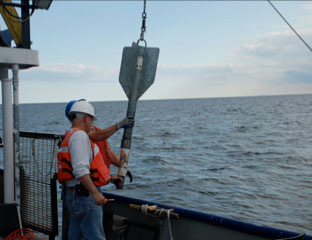Sedimentation in Lake Huron
The crew of the R/V LAURENTIAN prepare to deploy a gravity core down 93 meters to collect sediment from the bottom of the isolated sinkhole. Click image for larger view and image credit.
September 6, 2008
Val Klump
Director
University of Wisconsin-Milwaukee Great Lakes WATER Institute
The Laurentian Great Lakes are, essentially, “closed basins” – meaning that whatever flows into them from our rivers, whatever washes in from the shoreline, and whatever we dump into these inland seas, stays there almost indefinitely – or at least for a very long time. As a source of drinking water for almost 30 million people, it is easy to see why we are concerned about the pollution of our rivers and streams – we may very well end up drinking tomorrow what we toss in today.
Much of the material that enters the lakes from their watersheds ends up being deposited on the bottom of the lakes. Sediment has been accumulating in the deep basins for several thousand years, and these sediment deposits are one of the major biogeochemical sinks in the system.
The magnitude and speed with which this sink operates is an important process in determining how quickly the lakes clean themselves of pollutants, nutrients, and other biogeochemically important material. Sediments are the output side of the lakes biogeochemical ledger, and the budgets of many constituents, like phosphorus – an important nutrient controlling primary production – are controlled in large part by how efficiently this sink works.
In order to estimate the processes of sediment deposition and accumulation, scientists often collect sediment cores – vertical sections of sediment that reach from the surface of the sediment down tens of centimeters to meters in length. The deeper one goes in the sediment layers, the older the material – much like tree rings in an old pine or oak tree. In the Great Lakes, sediment at depth can be thousands of years old.
Typically sedimentation rates in the Great Lakes range up to a centimeter per year, with an average for Lake Michigan or Lake Huron closer to a millimeter per year. This means that on average every centimeter represents ~ 10 years. A core that is 50 centimeters long could be as young as 50 years or as old as 500 years or more. In order to determine the age of the sediment, scientists use a variety of techniques, but one of the most frequently used is “radionuclide geochronology” – or using naturally occurring radioactive elements to determine the date when sediment was initially deposited (similar to carbon-14 dating).
Val Klump removes a sediment sample from the gravity core for later analysis. Image courtesy of Thunder Bay Sinkholes 2008.
One of the most common radionuclides employed is an isotope of lead, Pb-210. Pb-210 has a 22.3 year half life (i.e. it decays by half every 22.3 years). This makes it ideal for determining sedimentation rates over the last 100 years or so. This is a particularly interesting period because this is the time during which humans have had the greatest impact on the lakes, and that impact is often recorded in the sediments. We can see the advent of land clearing during expansion of agriculture in the midwest, we can detect the atmospheric testing of nuclear weapons, and we can see the impact of human caused pollution.
In Lake Huron sinkholes we are attempting to measure how quickly these unique environments are accumulating material and how they differ from the rest of the lake's bottom. These sediments may be being formed rapidly in situ by the fixation of carbon by the microbial mats, or maybe the sinkholes act as sediment “traps” collecting and focusing material that helps fertilize the microbial communities. Cores collected will contain a story of the history of the sinkholes and hopefully tell us more about how these unusual systems came about and how they are sustained.
Sign up for the Ocean Explorer E-mail Update List.



















